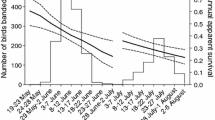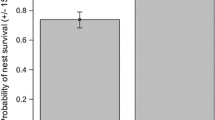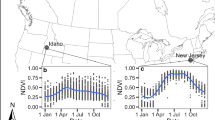Abstract
Population decline and the threat of extinction are realities currently facing many species. Yet, in most cases, the detailed demographic data necessary to identify causes of population decline are unavailable. Using 43 years (1975−2017) of data from a box-nesting population of tree swallows (Tachycineta bicolor), we identified reduced survival of offspring as a probable demographic cause of population decline. Poor fledging success was associated with increased predation and poor weather conditions during early nestling development. Low juvenile survival and subsequent recruitment was linked to poor weather conditions during the post-fledging period and may also be linked to conditions on the wintering grounds. Regional weather conditions during critical stages of breeding (early nestling and post-fledging) have become progressively worse over the 43-year study period. None of the other factors linked to offspring survival have similarly deteriorated. Overall, our results suggest tree swallows should be added to the growing list of species challenged by climate change, and that other species of aerial insect specialists may face similar impacts of climate change.




Similar content being viewed by others
References
Barnosky AD, Matske N, Tomiya S et al (2011) Has the earth’s sixth mass extinction already arrived? Nature 471:51–57. https://doi.org/10.1038/nature09678
Benton TG, Bryant DM, Cole L, Crick HQP (2002) Linking agricultural practice to insect and bird populations: a historical study over three decades. J Appl Ecol 39:673–687. https://doi.org/10.1046/j.1365-2664.2002.00745.x
Blyth M, Paine CWE, Paine CET (2019) The decline in nesting success of Tachycineta bicolor (Tree Swallow) over 38 years on Hardwood Island, Maine. Northeast Nat 26:236–250. https://doi.org/10.1656/045.026.0201
Cahill AE, Aiello-Lammens ME, Fisher-Reid MC et al (2012) How does climate change cause extinction? Proc R Soc B. https://doi.org/10.1098/rspb.2012.1890
Clark RG, Winkler DW, Dawson RD et al (2018) Geographical variation and environmental correlates of apparent survival rates in adult tree swallows Tachycineta bicolor. J Avian Biol. https://doi.org/10.1111/oik.02986
Climate Prediction Center (2018) Monthly atmospheric and SSI indices: Southern Oscillation Index (SOI)
COSEWIC (2007) COSEWIC assessment and update status report on the Gray Ratsnake Elaphe spiloides (Great Lakes/St. Lawrence population and Carolinian population) in Canada. Committee on the Status of Endangered Wildlife in Canada. Ottawa
Cox AR, Robertson RJ, Fedy BC et al (2018) Demographic drivers of local population decline in Tree Swallows (Tachycineta bicolor) in Ontario, Canada. Condor 120:842–851. https://doi.org/10.1650/CONDOR-18-42.1
Cox AR, Robertson RJ, Lendvai ÁZ et al (2019) Rainy springs linked to poor nestling growth in a declining avian aerial insectivore. Proc R Soc B 286:20190018. https://doi.org/10.1098/rspb.2019.0018
Dawson RD, Lawrie CC, O’Brien EL (2005) The importance of microclimate variation in determining size, growth and survival of avian offspring: experimental evidence from a cavity nesting passerine. Oecologia 144:499–507. https://doi.org/10.1007/s00442-005-0075-7
Dirzo R, Young HS, Galetti M et al (2014) Defaunation in the anthropocene. Science 345:401–406. https://doi.org/10.1126/science.1251817
Dunn P, Winkler DW (1999) Climate change has affected the breeding date of tree swallows throughout North America. Proc R Soc B Biol Sci 266:2487–2490. https://doi.org/10.1098/rspb.1999.0950
Environment Canada (2018) National climate data and information archive. Environment Canada, Ottawa
Evans KL, Wilson JD, Bradbury RB (2007) Effects of crop type and aerial invertebrate abundance on foraging barn swallows Hirundo rustica. Agric Ecosyst Environ 122:267–273. https://doi.org/10.1016/j.agee.2007.01.015
Frederiksen M, Harris MP, Daunt F et al (2004) Scale-dependent climate signals drive breeding phenology of three seabird species. Glob Chang Biol 10:1214–1221. https://doi.org/10.1111/j.1529-8817.2003.00794.x
Ghilain A, Belisle M (2008) Breeding success of tree swallows along a gradient of agricultural intensification. Ecol Appl 18:1140–1154. https://doi.org/10.1890/07-1107.1
Grüebler MU, Morand M, Naef-Daenzer B (2007) A predictive model of the density of airborne insects in agricultural environments. Agric Ecosyst Environ 123:75–80. https://doi.org/10.1016/j.agee.2007.05.001
Grüebler MU, Korner-Nievergelt F, Naef-Daenzer B (2014) Equal nonbreeding period survival in adults and juveniles of a long-distant migrant bird. Ecol Evol 4:756–765. https://doi.org/10.1002/ece3.984
Hallmann CA, Foppen RPB, van Turnhout CAM et al (2014) Declines in insectivorous birds are associated with high neonicotinoid concentrations. Nature 511:341–343. https://doi.org/10.1038/nature13531
Hallmann CA, Sorg M, Jongejans E et al (2017) More than 75 percent decline over 27 years in total flying insect biomass in protected areas. PLoS One 12:e0185809. https://doi.org/10.1371/journal.pone.0185809
Imlay TL, Mills Flemming J, Saldanha S et al (2018) Breeding phenology and performance for four swallows over 57 years: relationships with temperature and precipitation. Ecosphere 9:e02166. https://doi.org/10.1002/ecs2.2166
Inger R, Gregory R, Duffy JP et al (2015) Common European birds are declining rapidly while less abundant species’ numbers are rising. Ecol Lett 18:28–36. https://doi.org/10.1111/ele.12387
Jones J (2003) Tree swallows (Tachycineta bicolor): a new model organism? Auk 120:591–599
Kovacs KM, Lydersen C, Overland JE, Moore SE (2011) Impacts of changing sea-ice conditions on Arctic marine mammals. Mar Biodivers 41:181–194. https://doi.org/10.1007/s12526-010-0061-0
Krijgsveld KL, Visser GH, Daan S (2003) Foraging behavior and physiological changes in precocial quail chicks in response to low temperatures. Physiol Behav 79:311–319. https://doi.org/10.1016/S0031-9384(03)00117-3
Kunkel KE, Stevens LE, Stevens SE, et al (2013) Regional climate trends and scenarios for the U.S. national climate assessment. Part 1. Climate of the northeast U.S. 1–87
Landreth HF (1972) Physiological responses of Elaphe obsoleta and Pituophis melanoleucus to lowered ambient temperatures. Herpetologica 28:376–380. https://doi.org/10.2307/3890674
McKinnon L, Picotin M, Bolduc E et al (2012) Timing of breeding, peak food availability, and effects of mismatch on chick growth in birds nesting in the High Arctic. Can J Zool 90:961–971. https://doi.org/10.1139/z2012-064
Michel NL, Smith AC, Clark RG et al (2016) Differences in spatial synchrony and interspecific concordance inform guild-level population trends for aerial insectivorous birds. Ecography 39:774–786. https://doi.org/10.1111/ecog.01798
Nebel S, Mills A, McCracken JD, Taylor PD (2010) Declines of aerial insectivores in North America follow a geographic gradient. Avian Conserv Ecol 5:1. https://doi.org/10.5751/ACE-00391-050201
Parmesan C (2006) Ecological and evolutionary responses to recent climate change. Annu Ecol Evol Syst 37:637–669. https://doi.org/10.2307/annurev.ecolsys.37.091305.30000024
Parmesan C, Burrows MT, Duarte CM et al (2013) Beyond climate change attribution in conservation and ecological research. Ecol Lett 16:58–71. https://doi.org/10.1111/ele.12098
R Core Team (2018) R: a language and environment for statistical computing
Robertson RJ, Rendell WB (1990) A comparison of the breeding ecology of a secondary cavity nesting bird, the Tree Swallow (Tachycineta bicolor), in nest boxes and natural cavities. Can J Zool 68:1046–1052. https://doi.org/10.1139/z90-152
Robertson RJ, Stutchbury BJM, Cohen RR (1992) Tree Swallow: Tachycineta bicolor. The Birds of North America. Cornell Lab of Ornithology, Ithaca, pp 1–26
Sala OE, Chapin FS, Armesto JJ et al (2000) Global biodiversity scenarios for the Year 2100. Science 287:1770–1775. https://doi.org/10.1126/science.287.5459.1770
Shortall CR, Moore A, Smith E et al (2009) Long-term changes in the abundance of flying insects. Insect Conserv Divers 2:251–260. https://doi.org/10.1111/j.1752-4598.2009.00062.x
Shutler D, Hussell DJT, Norris DR et al (2012) Spatiotemporal patterns in nest box occupancy by tree swallows across North America. Avian Conserv Ecol 7:3. https://doi.org/10.5751/ACE-00517-070103
Sillett TS, Holmes RT (2005) Long-term demographic trends, limiting factors, and the strength of density dependence in a breeding population of a migratory songbird. Popul Ecol 32:426–436
Smith AC, Hudson MAR, Downes CM, Francis CM (2015) Change points in the population trends of aerial-insectivorous birds in North America: synchronized in time across species and regions. PLoS One 10:1–23. https://doi.org/10.1371/journal.pone.0130768
Sperry JH, Peak RG, Cimprich DA, Weatherhead PJ (2008) Snake activity affects seasonal variation in nest predation risk for birds. J Avian Biol 39:379–383. https://doi.org/10.1111/j.l600-0587.2010.06953.x
Stutchbury BJ, Robertson RJ (1987) Two methods of sexing adult tree swallows before they begin breeding. J Field Ornithol 58:236–242
Taylor LU, Woodworth BK, Sandercock BK, Wheelwright NT (2018) Demographic drivers of collapse of an island songbird population. Condor 120:828–841. https://doi.org/10.1650/CONDOR-18-75.1
Torok J, Toth L (1988) Density dependence in reproduction of the collared flycatcher (Ficedula albicollis) at high population levels. J Anim Ecol 57:251. https://doi.org/10.2307/4776
Visser ME, Holleman LJM, Gienapp P (2006) Shifts in caterpillar biomass phenology due to climate change and its impacts on the breeding biology of an insectivorous bird. Oecologia 147:164–172
Weegman MD, Arnold TW, Dawson RD et al (2017) Integrated population models reveal local weather conditions are the key drivers of population dynamics in an aerial insectivore. Oecologia 185:119–130. https://doi.org/10.1007/s00442-017-3890-8
Winkler DW (2006) Roosts and migrations of swallows. Hornero 21:85–97
Winkler DW, Allen PE (1996) The seasonal decline in tree swallow clutch size: physiological constraint or strategic adjustment? Ecology 77:922–932. https://doi.org/10.2307/2265512
Winkler DW, Wrege PH, Allen PE et al (2004) Breeding dispersal and philopatry in the tree swallow. Condor 106:768–776. https://doi.org/10.1650/7634
Winkler DW, Wrege PH, Allen PE et al (2005) The natal dispersal of tree swallows in a continuous mainland environment. J Anim Ecol 74:1080–1090. https://doi.org/10.1111/j.1365-2656.2005.01007.x
Winkler DW, Luo MK, Rakhimberdiev E (2013) Temperature effects on food supply and chick mortality in tree swallows (Tachycineta bicolor). Oecologia 173:129–138. https://doi.org/10.1007/s00442-013-2605-z
Zeileis A, Leisch F, Hornik K, Kleiber C (2002) Strucchange: an R Package for testing for structural change in linear regression models. J Stat Softw 7:1–38
Zeileis A, Kleiber C, Kraemer W, Hornik K (2003) Testing and dating of structural changes in practice. Comput Stat Data Anal 44:109–123
Zuur AF, Hilbe JM, Ieno EN (2013) A beginner’s guide to GLM and GLMM with R. Highland Statistics Ltd., Newburgh
Acknowledgements
We thank the many students who have collected data on the tree swallow population over the years and the Queen’s University Biological Station for their continued support. We thank Liam Bailey for his review of the original manuscript. FB was supported by Natural Sciences and Engineering Research Council of Canada (NSERC) Discovery Grant, Queen’s University, and the Canadian Foundation for Innovation (project #32672). ARC was supported by NSERC and Ontario graduate scholarships. RJR was supported by successive NSERC grants from 1975 to 2010. WBR was supported by an NSERC Postdoctoral Fellowship and NSERC postgraduate and Ontario graduate scholarships.
Author information
Authors and Affiliations
Contributions
RJR started the tree swallow monitoring project in 1975 and, with a succession of students, oversaw it until 2007. FB supervised the field studies and management of the entire data set beginning in 2008. WBR also contributed to the monitoring of the study population and collection of data (1986–1998). ARC and FB conceived the study. ARC and WBR compiled the data. ARC completed the analyses. ARC wrote the initial manuscript, with help from FB. All authors edited the manuscript.
Corresponding author
Ethics declarations
Ethical approval
All recent work was approved by the Queen’s University Animal Care Committee (protocol #2015-1572) and the Canadian Wildlife Service (CA0211 and banding permit 10771).
Additional information
Communicated by Markku Orell.
40+ years of tree swallow population monitoring, before and after avian aerial insectivores began declining, ties avian aerial insectivore population declines to increasingly rainy spring weather.
Electronic supplementary material
Below is the link to the electronic supplementary material.
Rights and permissions
About this article
Cite this article
Cox, A.R., Robertson, R.J., Rendell, W.B. et al. Population decline in tree swallows (Tachycineta bicolor) linked to climate change and inclement weather on the breeding ground. Oecologia 192, 713–722 (2020). https://doi.org/10.1007/s00442-020-04618-8
Received:
Accepted:
Published:
Issue Date:
DOI: https://doi.org/10.1007/s00442-020-04618-8




